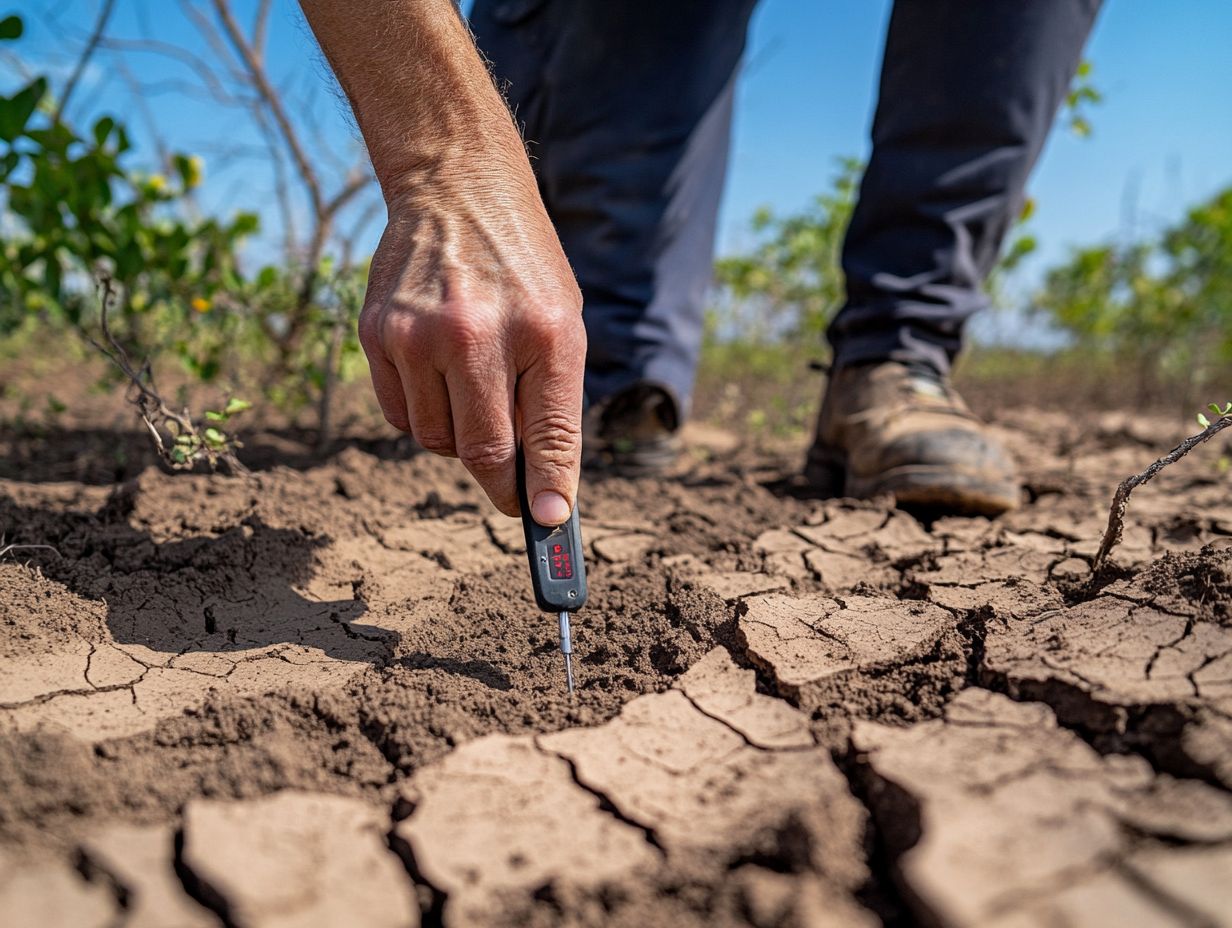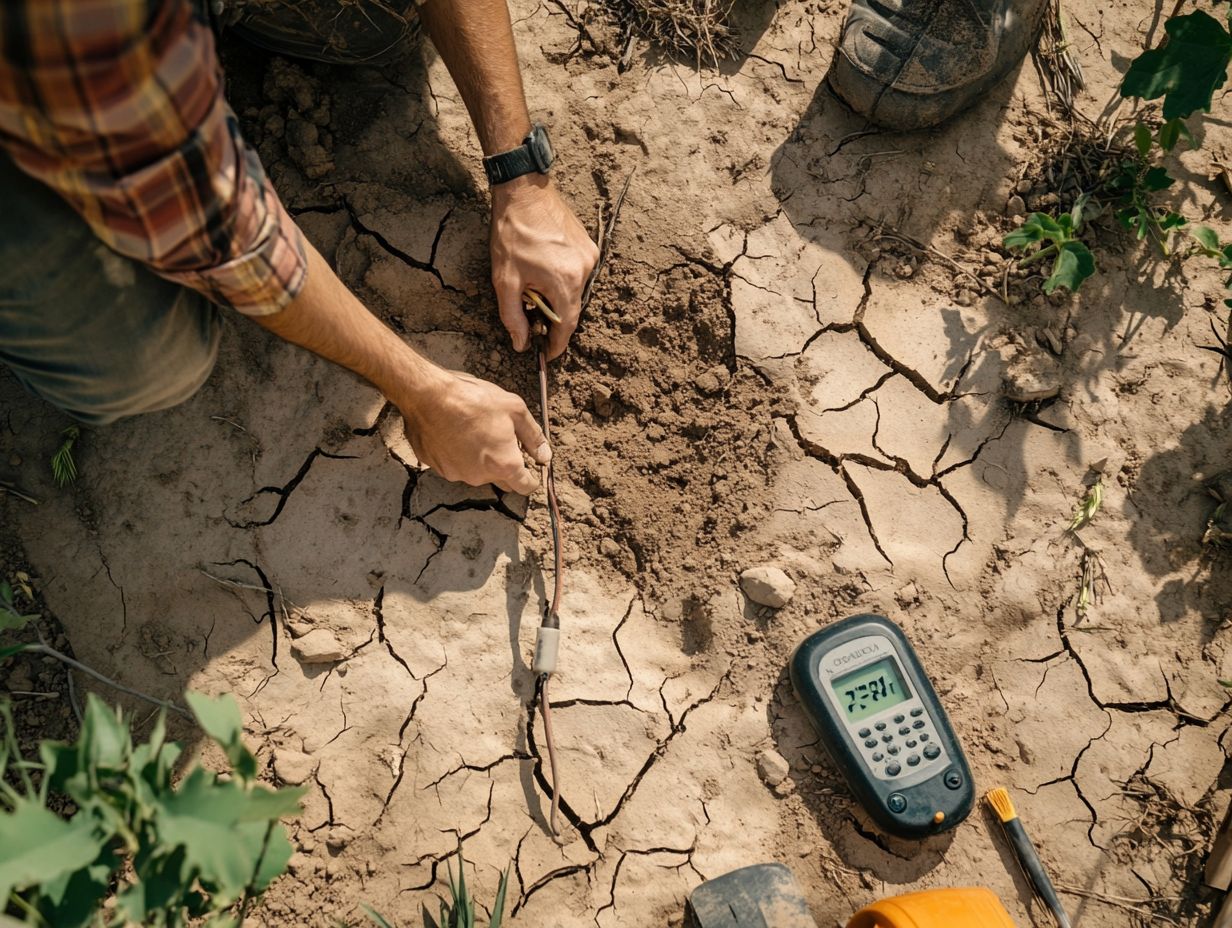How to Monitor Soil Health in Drought Areas?
In drought-stricken regions, maintaining soil health is essential for sustainable agriculture and ecosystem resilience. This is especially crucial as we confront ongoing challenges from climate change.
This article explores factors influencing soil quality during drought. It emphasizes the need for regular monitoring and examines both traditional and modern techniques for assessing soil health.
Improving soil health is a vital step in cultivating a more resilient environment. Let’s dive into effective strategies.
Contents
- Key Takeaways:
- Understanding Soil Health in Drought Areas
- Importance of Monitoring Soil Health
- Methods for Monitoring Soil Health
- Interpreting Soil Health Results
- Improving Soil Health in Drought Areas
- Frequently Asked Questions
- 1. How do I monitor soil health in drought areas?
- 2. Worried your soil isn’t healthy enough? Here are some signs to look out for!
- 3. How can I improve soil health in drought areas?
- 4. What is the role of soil health in drought resilience?
- 5. Are there any tools available for monitoring soil health in drought areas?
- 6. How often should I monitor soil health in drought areas?
Key Takeaways:

- Regular monitoring of soil health is crucial in drought areas to identify and address issues early.
- Traditional and modern techniques are available, but modern methods often yield more accurate results.
- Understanding soil health indicators and implementing practical solutions can enhance soil vitality.
Understanding Soil Health in Drought Areas
Understanding soil health in drought-prone areas ensures sustainable agricultural practices. This is vital for maintaining optimal crop performance, particularly in regions like Iowa, known for corn and soybean production.
Drought reduces water availability and negatively impacts soil properties. This affects nutrient uptake and microbial activity, both critical for healthy soil.
As climate change worsens these challenges, adopting effective farming practices is essential. These practices improve soil moisture retention and increase organic matter content.
Factors Affecting Soil Health in Drought Conditions
Soil moisture levels, nutrient absorption, and microbial activities all influence soil health during drought. Reduced moisture leads to diminished biological activity, impacting crop support.
Soil temperature is also key, affecting microbial metabolism and nutrient cycling. Maintaining balanced organic matter content helps retain moisture, and using cover crops like alfalfa can enhance soil structure.
A thoughtful crop rotation strategy enriches soil biodiversity, enabling it to withstand dry spells. These interconnected factors collectively influence soil health and agricultural productivity.
Importance of Monitoring Soil Health
Monitoring soil health is crucial for sustaining agricultural productivity during drought. Regular assessments of moisture content and nutrient levels, along with understanding how to monitor soil moisture levels, help in making informed decisions about irrigation and crop selection.
This proactive approach enhances crop performance and helps navigate challenging conditions effectively. Start monitoring your soil today for a better tomorrow!
Benefits of Regular Monitoring

Regularly monitoring soil health brings numerous advantages. These include enhancing nutrient movement, improving water absorption, and facilitating strategies for moisture conservation. By understanding the condition of your soil, you can make informed decisions regarding irrigation management and crop practices. Utilize soil moisture-monitoring devices for better insights.
These strategies are especially important in drought-prone areas like Iowa. Optimal soil health can significantly impact crop performance, particularly for crops like soybean and corn.
When you routinely assess your soil, you can identify nutrient deficiencies and fine-tune your fertilization strategies. This results in more effective nutrient uptake. This personalized approach not only enhances your yield potential but also prepares your crops to better endure stressful conditions.
Frequent soil assessments can also indicate when to implement interventions like organic amendments or cover cropping. These actions further strengthen resilience against drought. Ultimately, prioritizing soil health can secure a sustainable agricultural future while maximizing your productivity.
Methods for Monitoring Soil Health
Discover a variety of exciting options for monitoring soil health. You can blend traditional techniques with modern advancements that enhance both precision and efficiency.
Traditional methods often rely on visual assessments and basic soil tests. These provide a straightforward approach to understanding soil conditions.
In contrast, modern techniques leverage technology to reliably measure key factors such as soil organic carbon, microbial activity, and moisture levels. This gives you a comprehensive understanding of your soil s condition.
Traditional vs Modern Techniques
Traditional techniques for monitoring soil health typically involve manual sampling and visual assessments. Meanwhile, modern approaches harness technology for precise measurements of soil properties, nutrient uptake, and microbial activities. Your choice of method can greatly influence the insights you gain about soil health.
By examining soil structure, pH levels, and organic matter through conventional means, you can gather foundational insights. However, these methods can be time-consuming and prone to human error.
On the other hand, contemporary monitoring techniques such as remote sensing using satellite or drone technology to gather information from a distance and soil sensors enhance precision and enable real-time data collection. These advanced methods provide comprehensive evaluations of indicators like moisture content and biomass, improving your decision-making for agricultural practices.
It s important to note that while modern methods offer depth and breadth, they often require substantial investment in both equipment and training. This raises valid concerns about accessibility for smaller farming operations.
Interpreting Soil Health Results
Interpreting soil health results is a crucial step in understanding the overall condition of your soil and its ability to support plant life, particularly during drought conditions.
By examining various indicators such as soil organic matter content and the efficiency of nutrient movement, you can evaluate the effectiveness of your current practices. This will help you make informed adjustments as needed.
Understanding Soil Health Indicators

Understanding soil health indicators is crucial for assessing the viability of your soil, especially regarding moisture levels, organic matter, and tiny living things in the soil. These indicators offer valuable insights into nutrient cycling and overall soil health, enabling you to make informed decisions as a farmer.
By monitoring indicators like soil pH, texture, and respiration rates, you can effectively gauge how well your soil supports plant growth. Moisture levels play a direct role in influencing microbial activities, which affect the decomposition of organic matter.
Maintaining a healthy balance of these elements promotes robust plant development and sustains agricultural productivity over time. You can utilize specific tests to evaluate these indicators, enabling you to implement tailored management practices that enhance soil health.
Understanding these connections builds a strong base for caring for the land sustainably.
Improving Soil Health in Drought Areas
Act now to boost soil health in drought-prone areas! You can achieve this through practical solutions and innovative farming techniques.
By implementing strategies like ways to save water, cover crops, and balanced crop rotations, you can significantly enhance the resilience of your soils against challenging drought conditions.
Practical Solutions and Strategies
Implementing practical solutions and strategies to improve soil health in drought conditions can significantly enhance ways to save water and lead to better crop yields. Techniques like incorporating crop residue and adopting conservation tillage (which means reducing how much you plow the soil) can greatly bolster soil health.
Integrating cover crops into your rotation schedules further enhances moisture retention and suppresses weeds. This is crucial for maintaining soil health during drought.
Using crop residues as mulch creates a protective layer that minimizes evaporation, ensuring the underlying moisture stays intact. By combining these methods, you not only boost soil fertility but also combat erosion and maintain a more sustainable farming system.
Frequently Asked Questions
1. How do I monitor soil health in drought areas?

To monitor soil health in drought areas, you can use soil moisture sensors. It’s important to measure water infiltration rates and track soil temperature and moisture levels over time. This will help you understand soil health in drought gardening and assess water availability and nutrient uptake.
2. Worried your soil isn’t healthy enough? Here are some signs to look out for!
Some signs of poor soil health in drought areas include compacted soil, shallow root systems, and a lack of organic matter. These issues can significantly impact crop performance and farming practices.
3. How can I improve soil health in drought areas?
To improve soil health in drought areas, implement conservation practices like cover cropping. This enhances soil organic matter and moisture conservation while reducing tillage and adding organic matter to the soil.
4. What is the role of soil health in drought resilience?
Healthy soils, rich in soil organic carbon, can act as a buffer against the impacts of drought by increasing water holding capacity. They also reduce erosion and provide better nutrient availability for crops like corn, soybean, and alfalfa.
5. Are there any tools available for monitoring soil health in drought areas?
Yes, various tools and technologies are available for monitoring soil health in drought areas. These include remote sensing, soil moisture-monitoring devices, and soil health testing kits provided by organizations like Iowa State University Extension and the USDA.
Ready to improve your soil health? Start with these practices today!
6. How often should I monitor soil health in drought areas?
Check the condition of your soil at least once a year. It’s especially important to do this before and after extreme drought events.
Consider using best practices from trusted resources like Integrated Crop Management News to guide your monitoring efforts.






